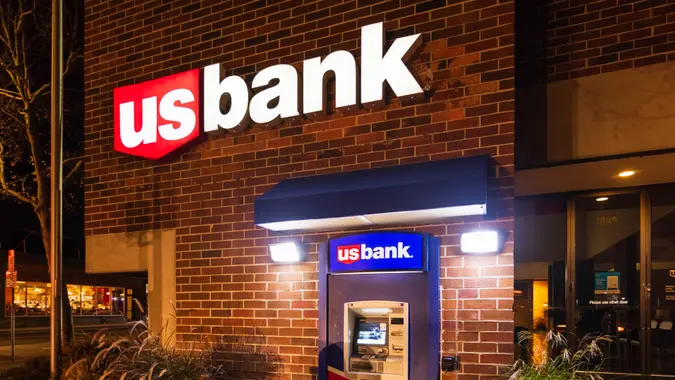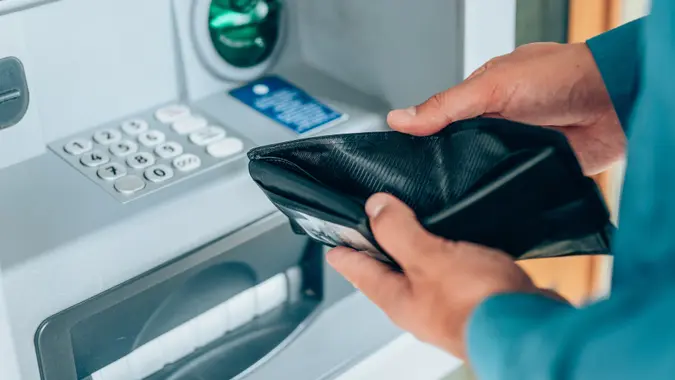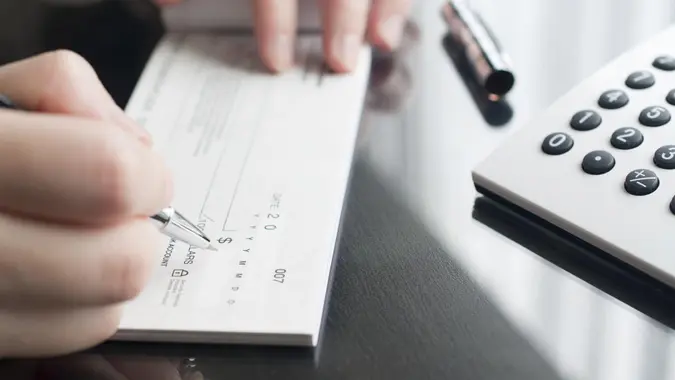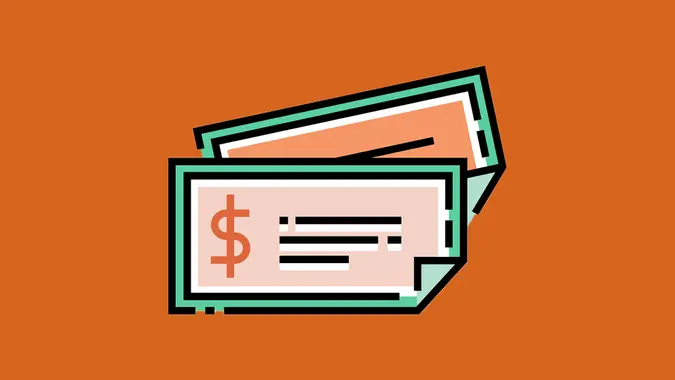Where To Get a Money Order: 6 Best Options

Commitment to Our Readers
GOBankingRates' editorial team is committed to bringing you unbiased reviews and information. We use data-driven methodologies to evaluate financial products and services - our reviews and ratings are not influenced by advertisers. You can read more about our editorial guidelines and our products and services review methodology.

20 Years
Helping You Live Richer

Reviewed
by Experts

Trusted by
Millions of Readers
Money orders can be purchased at the United States Postal Office (USPS), banks, credit unions, grocery stores and convenience stores. Costs vary by provider, but Walmart typically charges just $1. Here’s what to know about where to buy them and how much you’ll pay.
What Is a Money Order and How Does It Work?
A money order is a prepaid payment method with guaranteed funds. Money orders are considered a safe source of payment and are generally accepted in most places.
Common Uses:
- Deposits
- Paying bills
- Sending money securely
- International payments
Where To Get a Money Order: 6 Top Options
Here are some of the best places to get a money order, considering maximum limits and fees.
1. Banks and Credit Unions
One of the best places to get your hands on a money order is your local bank or credit union — as long as your bank offers competitive fees.
For example, Wells Fargo charges $5 per money order, which is significantly higher than other banks. Regions Bank, on the other hand, offers money orders for $2.
2. USPS
USPS is a cost-effective option for purchasing money orders, especially if you need one for under $500. Here is how the USPS money order fees work:
- If your money order is $500.00 or under, the fee is $2.55.
- If your money order is $500.01 to $1,000, the fee is $3.60.
- Military money orders of any value have a fee of $0.84.
As with all providers, limits apply. USPS caps domestic money orders at $1,000 and international money orders at $700.
3. Walmart and Retail Stores
Retailers like Walmart and grocery stores often offer money orders at their customer service counters. Walmart, for example, charges $1 or less, depending on the location, with a maximum value of $1,000 per money order.
Stores like Safeway, Kroger, Meijer and Publix also provide this service, typically through MoneyGram or Western Union.
Keep In Mind
Retail stores are a convenient choice due to their extended hours and accessibility. However, fees and limits vary by location, so it’s a good idea to call ahead to confirm details and pricing.
4. Convenience Stores and Grocery Stores
Circle K and 7-Eleven also sell money orders. They are typically capped at $1,000 and require cash or a debit card to purchase. Expect to pay either 1% to 3% of the transaction amount or a flat fee.
Grocery stores like Kroger, Publix and Safeway sell money orders often through MoneyGram and Western Union. Fees are typically $1 or $2 per money order.
5. Western Union and MoneyGram
Places like Western Union or MoneyGram locations provide money orders as part of their services. Western Union, for example, allows customers to purchase money orders for up to $999.99. Fees start at $1 but vary depending on location.
While these check-cashing services are convenient, they typically charge higher fees compared to retail stores and banks. Their services are ideal for people who need money orders quickly or need them outside of standard banking hours.
6. Online Options
Online options are limited. However, you may be able to get a money order online from your bank. You should check your mobile banking app or your bank’s website for details.
Keep in mind that requesting a money order online may involve additional fees and will take longer to process.
Money Order Details at a Glance
Here’s a quick breakdown of costs and limits across popular money order providers.
| Provider | Fees | Notes |
|---|---|---|
| Banks and credit unions | With certain accounts, money orders may be free | -Fees may be higher or lower depending on relationship with the bank -Can be convenient if you’re an existing customer -Max limit: $1,000 |
| USPS | -$2.55 if less than $500 -$3.60 if over $500.01 |
-Reliable and accepted domestically and internationally -Max limit: $1,000 |
| Walmart | $1.00 | -Cheapest place to get a money order -Max limit: $1,000 |
| Convenience stores | 1% to 3% of transaction | -Extended hours make it convenient -Max limit: $1,000 |
| Grocery stores | $1 to $2 | -Typically issued by Western Union or MoneyGram -Convenient if shopping there -Max limit: $1,000 |
| Western Union and MoneyGram | Starts at $1.00 | -Widely available -Good for urgent needs -Max limit: $999.99 |
| Online | Varies by bank | -Limited availability -Max limit: Typically $1,000 |
Factors To Consider When Choosing a Location
When figuring out where to get your money order, there are a few factors to keep front of mind:
- Fees: The cost of money orders can vary significantly, from under $1 to around $5. Make sure to compare fees to find the best deal.
- Limits: Most providers cap money orders at $1,000, with some offering even lower limits. Be sure to check the maximum amount allowed before making a trip.
- Convenience: Consider the hours and location of the retailer or bank. You may be able to find places with extended hours if you need a money order outside of banking hours.
- Additional services: Some providers, like Western Union, offer tracking, cashing and international options, which might be helpful depending on your situation.
Alternatives To Money Orders
If a money order isn’t the right choice for payment, you can opt for any of the following alternatives:
Peer-to-Peer (P2P) Payment Services
P2P apps like Zelle, Cash App and Venmo allow for easy money transfers since you can readily access them on your phone.
| Pros | Cons |
|---|---|
| Easy accessibility | No refunds for wrong recipient |
| Instant payment | Not great for larger transactions |
| Low or no fees on transfers | Both sender and recipient must have app |
Cashier’s Checks
Cashier’s checks are offered by banks and are even more secure for large transactions.
| Pros | Cons |
|---|---|
| Guaranteed funds by the bank | Must get in person at the bank |
| Best for large transactions | Fees can be high |
| Widely accepted for formal transactions | If lost, a replacement takes time |
Wire Transfers
Wire transfers are ideal for sending larger amounts of money quickly.
| Pros | Cons |
|---|---|
| Same-day or next-day transfer | Potentially high fees |
| Supports high-value domestic and international transactions | May take longer internationally |
| Direct bank-to-bank transfers | Hard to reverse once funds are sent |
ACH Transfers
ACH transfers are a good option for recurring payments.
| Pros | Cons |
|---|---|
| Low cost or free at many banks | Not instant |
| Good for recurring payments | Used only by U.S. financial institutions |
| Reliable and widely used in the U.S. | Daily transaction limits apply |
Final Take
Money orders are easy to find, affordable and widely accepted. By comparing providers on cost, convenience and limits, you can pick the best option for your needs — or explore alternatives if you need faster or larger transfers.
Money Order FAQs
Still have questions about buying or using money orders? Here are answers to some of the most common questions.- How much do money orders cost at Walmart vs. USPS?
- Walmart charges a low fee — $1 per money order.
- USPS takes a tiered approach:
- Money orders under $500 are $2.55
- Money orders greater than $500, but less than $1,000, are $3.60
- Can you buy a money order online?
- You typically cannot buy a money order online.
- Can you get a money order at 7-Eleven?
- Many 7-Elevens carry money orders through Western Union or MoneyGram.
- Where can I get a money order near me?
- You can go to your local post office, banks and credit unions, Walmart or convenience stores.
- How do you fill out a money order?
- To fill out a money order, write the recipient’s name, then add your name and address as the purchaser. Sign in the designated area, and if needed, include additional information in the memo line.
More on Money Order Fees
- CVS Money Order Fees
- Chase Money Order Fees
- Wells Fargo Money Order Fees
- Bank of America Money Order Fee
Cynthia Measom, Joshua Rodriguez, Elizabeth Constantineau, Caitlyn Moorhead and Kelli Francis contributed to the reporting for this article.
Our in-house research team and on-site financial experts work together to create content that’s accurate, impartial, and up to date. We fact-check every single statistic, quote and fact using trusted primary resources to make sure the information we provide is correct. You can learn more about GOBankingRates’ processes and standards in our editorial policy.
- Shopping Behaviour Xplained. "Do CVS Sell Money Orders? – An A To Z Guide For Your Payment."
- Watcher Guru. "Does Safeway do Money Orders?"
 Written by
Written by  Edited by
Edited by 
























